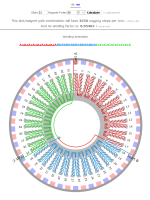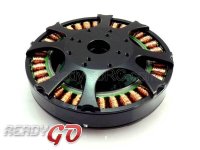atryz
1 mW
- Joined
- Apr 8, 2019
- Messages
- 10
Hi guys,
I am working on a high resolution angular positioning system for which I cannot use any reduction.
My main requirements are:
nominal speed: 1 revolution per day
max speed: 2 RPM
control: probably ODrive through incremental optical encoder
voltage: 48V
low cogging torque
OD: 200 mm
thickness, trying to stay under 30mm
shaft: OD 80mm or so
my previous attempt was a 21 slot, 16 poles, inrunner, 35mm thick, controlled by speed control; did a few torque measurements and based on the results it would have probably worked alright.
I getting back to this after 2 years and I want to change and improve a few things.
The first thing I am switching is going to an outrunner which should yield better torque and is a better fit with the rest of the machine.
The second is an easy one: position (rotary) encoder for control.
Increasing the number of poles with a similar (even) number of poles to maximize cogging steps (i.e. reduce cogging torque).
the 51/50 combination (like most N/N-1 or N/N+1) (for big enough N slot numbers) give that weird aAaA...BbBb... cCcC windings which isn't respective the typical 120 degrees found on 12/14 (or 36/42, etc.). I am thinking due the extremely low speed requirements that this combination shouldn't be problem, but what do you guys think?
Also since the speed is super slow, is it fair to assume that 1mm lamination shouldn't be a problem? My first try used 0.5mm laminations.
any pointer would help!
cheers
I am working on a high resolution angular positioning system for which I cannot use any reduction.
My main requirements are:
nominal speed: 1 revolution per day
max speed: 2 RPM
control: probably ODrive through incremental optical encoder
voltage: 48V
low cogging torque
OD: 200 mm
thickness, trying to stay under 30mm
shaft: OD 80mm or so
my previous attempt was a 21 slot, 16 poles, inrunner, 35mm thick, controlled by speed control; did a few torque measurements and based on the results it would have probably worked alright.
I getting back to this after 2 years and I want to change and improve a few things.
The first thing I am switching is going to an outrunner which should yield better torque and is a better fit with the rest of the machine.
The second is an easy one: position (rotary) encoder for control.
Increasing the number of poles with a similar (even) number of poles to maximize cogging steps (i.e. reduce cogging torque).
the 51/50 combination (like most N/N-1 or N/N+1) (for big enough N slot numbers) give that weird aAaA...BbBb... cCcC windings which isn't respective the typical 120 degrees found on 12/14 (or 36/42, etc.). I am thinking due the extremely low speed requirements that this combination shouldn't be problem, but what do you guys think?
Also since the speed is super slow, is it fair to assume that 1mm lamination shouldn't be a problem? My first try used 0.5mm laminations.
any pointer would help!
cheers



